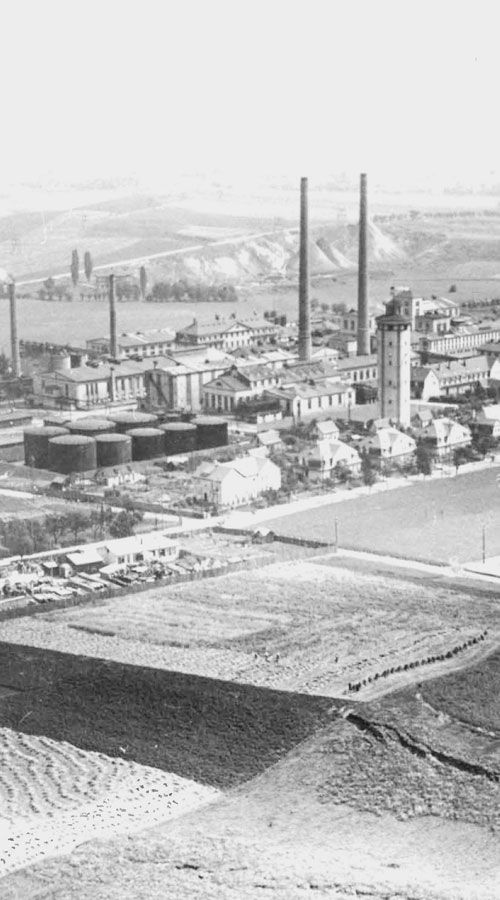The DEA site in Rositz Prof. Dr. Manfred Grieger


Aerial view of the DEA site in Rositz. The photo was taken around 1934.
The DEA site in Rositz – supplier to the Nazi war economy and place of forced labour
Prof. Dr. Manfred Grieger
(Georg-August-University, Goettingen)
The Rositz mineral oil works with the associated lignite mines and briquette and carbonisation plants are an example of the decentralised DEA group structures during the Nazi era. However, the refinery located between Altenburg and Borna, which produced heating oil for the navy from lignite tar using a specially developed distillation process, was already established as early as October 1916. The direct armaments industry purpose was largely lost after the First World War, so that the capacities created were not fully utilised.
Hope for a new upswing
With the rise to power of the National Socialists in the German Reich on 30 January 1933, the site management of the Rositz mineral oil works hoped that the crisis would be overcome. However, of the more than ten managers working on site, only two joined the NSDAP. Nevertheless, the replacement of the trade unions by the German Labour Front and the removal of works councils played into the hands of the management due to the “pacification of the company”. On 28 September 1934, company regulations geared towards the Nazi conditions also came into force.
Since an armaments expansion was a political objective, rearmament and the Nazi autarky policy provided impetus for “enlargements and extensions”. By 1936, DEA had increased its production capacity with a second cracking plant and a second carbonisation plant in the nearby town of Regis. The supply contract concluded with the navy at the turn of the year 1937/38 led to further growth. However, a lack of building materials delayed the completion of the expansion of the refinery and carbonisation works, which had begun in 1938. A coal dust explosion at the Regis II carbonisation plant on 11 April 1939 set back the expansion plans. By 1943, heating oil production had risen further to 161,000 tonnes per year and total annual production to 273,000 tonnes. The production of heating oil and diesel fuel went almost entirely to the navy.
Number of forced labourers deployed rose rapidly
The growing demand for workers could not be met on the local labour market, so the company initially recruited 850 German workers from the Sudetenland and Czechs, who were mainly housed in so-called “Gemeinschaftslager” (community camps). The use of temporary replacement workers during the war led to the establishment of a forced labour system in companies, which greatly disadvantaged racially discriminated people from Eastern Europe or Jews with regard to accommodation, care and treatment.
In February 1941, the first barrack camp for 300 French prisoners of war was set up at the Regis coal works. At the beginning of 1942, the lignite companies received 823 male and 25 female Eastern workers to replace the initially recruited Croatian civilian workers. In addition to 1,050 civilian foreigners, the workforce also included 875 prisoners of war (601 French, 269 Red Army and 5 Serbs). They accounted for 27.3 per cent of the total workforce. By mid-August 1944, the proportion of foreigners was already 48 per cent. At the carbonisation plants and the refinery, the proportion of foreign forced labourers remained somewhat lower at 31.6 percent due to the higher level of mechanisation. However, operation of all parts of the DEA site in Rositz relied on forced labour.
In the second half of the war, the local war society, which was based on subordination, suffered a growing loss of control. Initially, the company took action against “idling at work” with company fines. The Dutchman Adrianus Jager was sent to the dreaded “Römhild” work education camp run by the Gestapo in Weimar as a deterrent. Several men received prison sentences for “breach of employment contract”, i.e. for leaving the workplace without permission. The deprivation and repression could indeed have deadly consequences. Alexei Parschin from Stalino, who was born in 1910 and had been working at the Regis mining facility since 23 May 1942, was shot dead by the police on 16 February 1945 “while stealing potatoes”. The number of foreign deaths in the mining operations totalled at least 28 people.
Forced labourers to secure reconstruction after bombing
The Rositz complex was spared direct bombing raids for a long time. On 16 August 1944, hundreds of bombs fell on the plant, causing widespread fires and severe destruction to buildings, pipelines and tank and container facilities. The Kyffhäuser task force of the Todt organisation took over the construction management for the restoration of the facilities. Another heavy attack with 400 bomb hits on 2 March 1945 finally destroyed the prospect of putting the refinery back into operation. Despite that, on 31 March 1945, 499 foreigners, mostly French and Italians, were among the 1,552 employees at the Rositz mineral oil plant. An additional 1,669 men, mainly construction workers, did however work at the site for external companies or the Todt organisation, so the total number of people working for DEA on site was 3,230. Of these, 691 were foreign civilian workers, 569 were prisoners of war and 331 were so-called ‘Mischlinge’, in other words, Germans discriminated against as Jews. Forced labourers of various categories still made up half of the workforce until the last days of the war, even though their exploitation no longer yielded any economically viable return.


About the author
Professor Dr. Manfred Grieger is an economic historian and honorary professor at Georg August University in Goettingen. From 1998 to 2016, he was Head of Historical Communication in Corporate Communications at Volkswagen. Grieger previously earned a doctorate (Dr. phil.) with his thesis “The Volkswagen plant and its workers during the Third Reich, 1933-1948”. Grieger is a member of the Historical Commission for Lower Saxony and Bremen and of the Working Group for Critical Corporate and Industrial History.